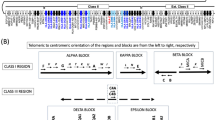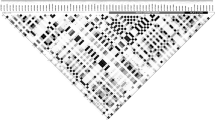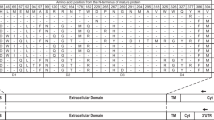Abstract
NK cell immunoglobulin-like receptor (KIR) haplotype-specific DNA fragments were sequenced to identify centromeric and telomeric allele-level haplotype structures and their frequencies from 76 unrelated individuals with European ancestry. Analysis was simplified by redefining the 5′ boundary of the centromeric KIR gene cluster to include only exons 7–9 of KIR3DL3. Three consensus allele-level haplotypes were identified for a centromeric gene presence/absence structure designated as Cen-A1. KIR3DL3*00201 (exons 7–9)∼KIR2DL3*001∼KIR2DL1*00302 was the most frequent (37.5%) centromeric structure. Single consensus haplotypes were observed for haplotype structures Cen-B1 and Cen-B2. Six Tel-A1 and two Tel-B1 consensus haplotypes were observed; the most prevalent (23.0%) was KIR2DL4*00102∼KIR3DL1*002∼KIR2DS4*00101∼KIR3DL2*002. A small number of nucleotide substitutions (⩽3) in the coding regions of the functional KIR genes created microvariants of the consensus haplotypes. Eight less common haplotype structures were also detected. Four carried hybrid genes formed during gene deletion events, two carried an insertion with a 2DL5/3DP1 fusion gene and two included a very large insertion. These data show that the KIR gene complex is composed of a limited number of conserved allele-level centromeric and telomeric haplotypes that have diversified by mutation, recombination within a locus and unequal crossing over.
This is a preview of subscription content, access via your institution
Access options
Subscribe to this journal
Receive 6 digital issues and online access to articles
$119.00 per year
only $19.83 per issue
Buy this article
- Purchase on Springer Link
- Instant access to full article PDF
Prices may be subject to local taxes which are calculated during checkout





Similar content being viewed by others
References
Bryceson YT, Long EO . Line of attack: NK cell specificity and integration of signals. Curr Opin Immunol 2008; 20: 344–352.
Lanier LL . NK cell recognition. Annu Rev Immunol 2005; 23: 225–274.
Moretta A, Vitale M, Bottino C, Orengo AM, Morelli L, Augugliaro R et al. P58 molecules as putative receptors for major histocompatibility complex (MHC) class I molecules in human natural killer (NK) cells. Anti-p58 antibodies reconstitute lysis of MHC class I-protected cells in NK clones displaying different specificities. J Exp Med 1993; 178: 597–604.
Colonna M, Borsellino G, Falco M, Ferrara GB, Strominger JL . HLA-C is the inhibitory ligand that determines dominant resistance to lysis by NK1- and NK2-specific natural killer cells. Proc Natl Acad Sci USA 1993; 90: 12000–12004.
Litwin V, Gumperz J, Parham P, Phillips JH, Lanier LL . NKB1: a natural killer cell receptor involved in the recognition of polymorphic HLA-B molecules. J Exp Med 1994; 180: 537–543.
Kollnberger S, Chan A, Sun MY, Chen LY, Wright C, di Gleria K et al. Interaction of HLA-B27 homodimers with KIR3DL1 and KIR3DL2, unlike HLA-B27 heterotrimers, is independent of the sequence of bound peptide. Eur J Immunol 2007; 37: 1313–1322.
Winter CC, Gumperz JE, Parham P, Long EO, Wagtmann N . Direct binding and functional transfer of NK cell inhibitory receptors reveal novel patterns of HLA-C allotype recognition. J Immunol 1998; 161: 571–577.
Biassoni R, Falco M, Cambiaggi A, Costa P, Verdiani S, Pende D et al. Amino acid substitutions can influence the natural killer (NK)-mediated recognition of HLA-C molecules. Role of serine-77 and lysine-80 in the target cell protection from lysis mediated by ‘group 2’ or ‘group 1’ NK clones. J Exp Med 1995; 182: 605–609.
Graef T, Moesta AK, Norman PJ, Abi-Rached L, Vago L, Older Aguilar AM et al. KIR2DS4 is a product of gene conversion with KIR3DL2 that introduced specificity for HLA-A*11 while diminishing avidity for HLA-C. J Exp Med 2009; 206: 2557–2572.
Kikuchi-Maki A, Yusa S, Catina TL, Campbell KS . KIR2DL4 is an IL-2-regulated NK cell receptor that exhibits limited expression in humans but triggers strong IFN-gamma production. J Immunol 2003; 171: 3415–3425.
Rajagopalan S, Bryceson YT, Kuppusamy SP, Geraghty DE, van der MA, Joosten I et al. Activation of NK cells by an endocytosed receptor for soluble HLA-G. PLoS Biol 2006; 4: e9.
Trowsdale J, Barten R, Haude A, Stewart CA, Beck S, Wilson MJ . The genomic context of natural killer receptor extended gene families. Immunol Rev 2001; 181: 20–38.
Valiante NM, Uhrberg M, Shilling HG, Lienert-Weidenbach K, Arnett KL, D’Andrea A et al. Functionally and structurally distinct NK cell receptor repertoires in the peripheral blood of two human donors. Immunity 1997; 7: 739–751.
Norman PJ, Stephens HA, Verity DH, Chandanayingyong D, Vaughan RW . Distribution of natural killer cell immunoglobulin-like receptor sequences in three ethnic groups. Immunogenetics 2001; 52: 195–205.
Hsu KC, Chida S, Dupont B, Geraghty DE . The killer cell immunoglobulin-like receptor (KIR) genomic region: gene-order, haplotypes and allelic polymorphism. Immunol Rev 2002; 190: 40–52.
Ordonez D, Meenagh A, Gomez-Lozano N, Castano J, Middleton D, Vilches C . Duplication, mutation and recombination of the human orphan gene KIR2DS3 contribute to the diversity of KIR haplotypes. Genes Immun 2008; 9: 431–437.
Gomez-Lozano N, Gardiner CM, Parham P, Vilches C . Some human KIR haplotypes contain two KIR2DL5 genes: KIR2DL5A and KIR2DL5B. Immunogenetics 2002; 54: 314–319.
Pyo CW, Guethlein LA, Vu Q, Wang R, Abi-Rached L, Norman PJ et al. Different patterns of evolution in the centromeric and telomeric regions of group A and B haplotypes of the human killer cell Ig-like receptor locus. PLoS ONE 2010; 5: e15115.
Wilson MJ, Torkar M, Haude A, Milne S, Jones T, Sheer D et al. Plasticity in the organization and sequences of human KIR/ILT gene families. Proc Natl Acad Sci USA 2000; 97: 4778–4783.
Middleton D, Meenagh A, Gourraud PA . KIR haplotype content at the allele level in 77 Northern Irish families. Immunogenetics 2007; 59: 145–158.
Gourraud PA, Meenagh A, Cambon-Thomsen A, Middleton D . Linkage disequilibrium organization of the human KIR superlocus: implications for KIR data analyses. Immunogenetics 2010; 62: 729–740.
Martin MP, Bashirova A, Traherne J, Trowsdale J, Carrington M . Cutting edge: expansion of the KIR locus by unequal crossing over. J Immunol 2003; 171: 2192–2195.
Traherne JA, Martin M, Ward R, Ohashi M, Pellett F, Gladman D et al. Mechanisms of copy number variation and hybrid gene formation in the KIR immune gene complex. Hum Mol Genet 2010; 19: 737–751.
Gomez-Lozano N, Estefania E, Williams F, Halfpenny I, Middleton D, Solis R et al. The silent KIR3DP1 gene (CD158c) is transcribed and might encode a secreted receptor in a minority of humans, in whom the KIR3DP1, KIR2DL4 and KIR3DL1/KIR3DS1 genes are duplicated. Eur J Immunol 2005; 35: 16–24.
Norman PJ, Abi-Rached L, Gendzekhadze K, Hammond JA, Moesta AK, Sharma D et al. Meiotic recombination generates rich diversity in NK cell receptor genes, alleles, and haplotypes. Genome Res 2009; 19: 757–769.
Robinson J, Mistry K, McWilliam H, Lopez R, Marsh SG . IPD—the Immuno Polymorphism Database. Nucleic Acids Res 2010; 38 (Database issue): D863–D869.
VandenBussche CJ, Dakshanamurthy S, Posch PE, Hurley CK . A single polymorphism disrupts the killer Ig-like receptor 2DL2/2DL3 D1 domain. J Immunol 2006; 177: 5347–5357.
Moesta AK, Norman PJ, Yawata M, Yawata N, Gleimer M, Parham P . Synergistic polymorphism at two positions distal to the ligand-binding site makes KIR2DL2 a stronger receptor for HLA-C than KIR2DL3. J Immunol 2008; 180: 3969–3979.
Yawata M, Yawata N, Draghi M, Little AM, Partheniou F, Parham P . Roles for HLA and KIR polymorphisms in natural killer cell repertoire selection and modulation of effector function. J Exp Med 2006; 203: 633–645.
Li H, Pascal V, Martin MP, Carrington M, Anderson SK . Genetic control of variegated KIR gene expression: polymorphisms of the bi-directional KIR3DL1 promoter are associated with distinct frequencies of gene expression. PLoS Genet 2008; 4: e1000254.
Shilling HG, Guethlein LA, Cheng NW, Gardiner CM, Rodriguez R, Tyan D et al. Allelic polymorphism synergizes with variable gene content to individualize human KIR genotype. J Immunol 2002; 168: 2307–2315.
Hou L, Chen M, Jiang B, Wu D, Ng J, Hurley CK . Thirty allele-level haplotypes centered around KIR2DL5 define the diversity in an African American population. Immunogenetics 2010; 62: 491–498.
Hou L, Steiner NK, Chen M, Belle I, Kubit AL, Ng J et al. Limited allelic diversity of stimulatory two domain killer immunoglobulin-like receptors. Hum Immunol 2008; 69: 174–178.
Mulrooney TJ, Hou L, Steiner NK, Chen M, Belle I, Ng J et al. Promoter variants of KIR2DL5 add to diversity and may impact gene expression. Immunogenetics 2008; 60: 287–294.
Belle I, Hou L, Chen M, Steiner NK, Ng J, Hurley CK . Investigation of killer cell immunoglobulin-like receptor gene diversity in KIR3DL1 and KIR3DS1 in a transplant population. Tissue Antigens 2008; 71: 434–439.
Hou L, Chen M, Steiner NK, Belle I, Turino C, Ng J et al. Seventeen novel alleles add to the already extensive KIR3DL3 diversity. Tissue Antigens 2007; 70: 449–454.
Gedil MA, Steiner NK, Hurley CK . KIR3DL2: diversity in a hematopoietic stem cell transplant population. Tissue Antigens 2007; 70: 228–232.
Hou LH, Steiner NK, Chen M, Belle I, Ng J, Hurley CK . KIR2DL1 allelic diversity: four new alleles characterized in a bone marrow transplant population and three families. Tissue Antigens 2007; 69: 250–254.
Shulse C, Steiner NK, Hurley CK . Allelic diversity in KIR2DL4 in a bone marrow transplant population: description of three novel alleles. Tissue Antigens 2007; 70: 157–159.
Jones DC, Hiby SE, Moffett A, Trowsdale J, Young NT . Nature of allelic sequence polymorphism at the KIR3DL3 locus. Immunogenetics 2006; 58: 614–627.
Norman PJ, Abi-Rached L, Gendzekhadze K, Korbel D, Gleimer M, Rowley D et al. Unusual selection on the KIR3DL1/S1 natural killer cell receptor in Africans. Nat Genet 2007; 39: 1092–1099.
Gomez-Lozano N, Trompeter HI, de Pablo R, Estefania E, Uhrberg M, Vilches C . Epigenetic silencing of potentially functional KIR2DL5 alleles: implications for the acquisition of KIR repertoires by NK cells. Eur J Immunol 2007; 37: 1954–1965.
Ordonez D, Gomez-Lozano N, Vilches C . The 5′ intergenic, promoter, pseudoexon 3 and complete coding sequences of the hybrid gene KIR2DS3*002. Tissue Antigens 2008; 72: 504–505.
Williams F, Maxwell LD, Halfpenny IA, Meenagh A, Sleator C, Curran MD et al. Multiple copies of KIR 3DL/S1 and KIR 2DL4 genes identified in a number of individuals. Hum Immunol 2003; 64: 729–732.
Martin AM, Kulski JK, Gaudieri S, Witt CS, Freitas EM, Trowsdale J et al. Comparative genomic analysis, diversity and evolution of two KIR haplotypes A and B. Gene 2004; 335: 121–131.
Wall JD, Pritchard JK . Haplotype blocks and linkage disequilibrium in the human genome. Nat Rev Genet 2003; 4: 587–597.
Kauppi L, Sajantila A, Jeffreys AJ . Recombination hotspots rather than population history dominate linkage disequilibrium in the MHC class II region. Hum Mol Genet 2003; 12: 33–40.
Torkar M, Norgate Z, Colonna M, Trowsdale J, Wilson MJ . Isotypic variation of novel immunoglobulin-like transcript/killer cell inhibitory receptor loci in the leukocyte receptor complex. Eur J Immunol 1998; 28: 3959–3967.
Trundley AE, Hiby SE, Chang C, Sharkey AM, Santourlidis S, Uhrberg M et al. Molecular characterization of KIR3DL3. Immunogenetics 2006; 57: 904–916.
Rajalingam R, Parham P, Abi-Rached L . Domain shuffling has been the main mechanism forming new hominoid killer cell Ig-like receptors. J Immunol 2004; 172: 356–369.
Bari R, Bell T, Leung WH, Vong QP, Chan WK, Das GN et al. Significant functional heterogeneity among KIR2DL1 alleles and a pivotal role of arginine 245. Blood 2009; 114: 5182–5190.
Moesta AK, Graef T, Abi-Rached L, Older Aguilar AM, Guethlein LA, Parham P . Humans differ from other hominids in lacking an activating NK cell receptor that recognizes the C1 epitope of MHC class I. J Immunol 2010; 185: 4233–4237.
Sivori S, Carlomagno S, Falco M, Romeo E, Moretta L, Moretta A . Natural killer cells expressing the KIR2DS1 activating receptor efficiently kill T cell blasts and dendritic cells: implications in haploidentical HSCT. Blood 2011; 117: 4284–4292.
VandenBussche CJ, Mulrooney TJ, Frazier WR, Dakshanamurthy S, Hurley CK . Dramatically reduced surface expression of NK cell receptor KIR2DS3 is attributed to multiple residues throughout the molecule. Genes Immunity 2009; 10: 162–173.
Goodridge JP, Lathbury LJ, Steiner NK, Shulse CN, Pullikotil P, Seidah NG et al. Three common alleles of KIR2DL4 (CD158d) encode constitutively expressed, inducible and secreted receptors in NK cells. Eur J Immunol 2007; 37: 199–211.
Middleton D, Gonzalez A, Gilmore PM . Studies on the expression of the deleted KIR2DS4*003 gene product and distribution of KIR2DS4 deleted and nondeleted versions in different populations. Hum Immunol 2007; 68: 128–134.
Taner SB, Pando MJ, Roberts A, Schellekens J, Marsh SG, Malmberg KJ et al. Interactions of NK cell receptor KIR3DL1*004 with chaperones and conformation-specific antibody reveal a functional folded state as well as predominant intracellular retention. J Immunol 2011; 186: 62–72.
Jonsson AH, Yokoyama WM . Natural killer cell tolerance licensing and other mechanisms. Adv Immunol 2009; 101: 27–79.
Shah R, Selby ST, Yokley B, Slack RS, Hurley CK, Posch PE . TNF, LTA and TGFB1 genotype distributions among acute graft-vs-host disease subsets after HLA-matched unrelated hematopoietic stem cell transplantation: a pilot study. Tissue Antigens 2009; 74: 50–56.
Lancaster AK, Single RM, Solberg OD, Nelson MP, Thomson G . PyPop update—a software pipeline for large-scale multilocus population genomics. Tissue Antigens 2007; 69 (Suppl 1): 192–197.
Lancaster AK, Nelson MP, Single RM, Meyer D, Thomson G . PyPop: a software framework for population genomics: analyzing large-scale multi-locus genotype data. In: Altman RB, Dunker K, Hunter L, Jung T, Klein T (eds). Pacific Symposium on Biocomputing 8. World Scientific: Singapore, 2003: 514–525.
Guo SW, Thompson EA . Performing the exact test of Hardy–Weinberg proportion for multiple alleles. Biometrics 1992; 48: 361–372.
Meyer D, Single R, Mack SJ, Lancaster A, Nelson MP, Erlich HA et al. 13th IHWS anthropology/human genetic diversity joint report. Chapter 4. Single locus polymorphism of classical HLA genes. In: Hansen JA (ed). Immunobiology of the Human MHC. International Histocompatibility Working Group Press: Seattle, 2006: 653–704.
Vilches C, Castano J, Gomez-Lozano N, Estefania E . Facilitation of KIR genotyping by a PCR-SSP method that amplifies short DNA fragments. Tissue Antigens 2007; 70: 415–422.
Vilches C, Gardiner CM, Parham P . Gene structure and promoter variation of expressed and nonexpressed variants of the KIR2DL5 gene. J Immunol 2000; 165: 6416–6421.
Gomez-Lozano N, Vilches C . Genotyping of human killer-cell immunoglobulin-like receptor genes by polymerase chain reaction with sequence-specific primers: an update. Tissue Antigens 2002; 59: 184–193.
Rogers AR, Harpending H . Population growth makes waves in the distribution of pairwise genetic differences. Mol Biol Evol 1992; 9: 552–569.
Slatkin M, Hudson RR . Pairwise comparisons of mitochondrial DNA sequences in stable and exponentially growing populations. Genetics 1991; 129: 555–562.
Librado P, Rozas J . DnaSP v5: a software for comprehensive analysis of DNA polymorphism data. Bioinformatics 2009; 25: 1451–1452.
Saitou N, Nei M . The neighbor-joining method: a new method for reconstructing phylogenetic trees. Mol Biol Evol 1987; 4: 406–425.
Felsenstein J . Confidence limits on phylogenies: an approach using the bootstrap. Evolution 1985; 39: 783–791.
Tamura K, Dudley J, Nei M, Kumar S . MEGA4: Molecular Evolutionary Genetics Analysis (MEGA) software version 4.0. Mol Biol Evol 2007; 24: 1596–1599.
Mandelboim O, Reyburn HT, Vales-Gomez M, Pazmany L, Colonna M, Borsellino G et al. Protection from lysis by natural killer cells of group 1 and 2 specificity is mediated by residue 80 in human histocompatibility leukocyte antigen C alleles and also occurs with empty major histocompatibility complex molecules. J Exp Med 1996; 184: 913–922.
Katz G, Markel G, Mizrahi S, Arnon TI, Mandelboim O . Recognition of HLA-Cw4 but not HLA-Cw6 by the NK cell receptor killer cell Ig-like receptor two-domain short tail number 4. J Immunol 2001; 166: 7260–7267.
Sivori S, Falco M, Carlomagno S, Romeo E, Soldani C, Bensussan A et al. A novel KIR-associated function: evidence that CpG DNA uptake and shuttling to early endosomes is mediated by KIR3DL2. Blood 2010; 116: 1637–1647.
Hansasuta P, Dong T, Thananchai H, Weekes M, Willberg C, Aldemir H et al. Recognition of HLA-A3 and HLA-A11 by KIR3DL2 is peptide-specific. Eur J Immunol 2004; 34: 1673–1679.
Acknowledgements
This research is supported by funding from the Office of Naval Research N00014-08-1-1078 and N00014-10-1-0199. The views expressed in this paper are those of the authors and do not reflect the official policy or position of the Department of the Navy, the Department of Defense or the US government. We thank Rebecca Slack for assistance.
Author information
Authors and Affiliations
Corresponding author
Ethics declarations
Competing interests
The authors declare no conflict of interest.
Additional information
Supplementary Information accompanies the paper on Genes and Immunity website
Supplementary information
Rights and permissions
About this article
Cite this article
Hou, L., Chen, M., Ng, J. et al. Conserved KIR allele-level haplotypes are altered by microvariation in individuals with European ancestry. Genes Immun 13, 47–58 (2012). https://doi.org/10.1038/gene.2011.52
Received:
Accepted:
Published:
Issue Date:
DOI: https://doi.org/10.1038/gene.2011.52
Keywords
This article is cited by
-
Comparative genetics of KIR haplotype diversity in humans and rhesus macaques: the balancing act
Immunogenetics (2022)
-
Association of killer cell immunoglobulin-like receptors with endemic Burkitt lymphoma in Kenyan children
Scientific Reports (2021)
-
Genotype B of Killer Cell Immunoglobulin-Like Receptor is Related with Gastric Cancer Lesions
Scientific Reports (2018)
-
Killer-cell Immunoglobulin-like Receptor gene linkage and copy number variation analysis by droplet digital PCR
Genome Medicine (2014)
-
Recombinant structures expand and contract inter and intragenic diversification at the KIR locus
BMC Genomics (2013)



